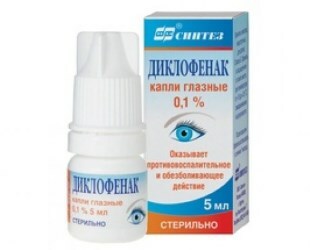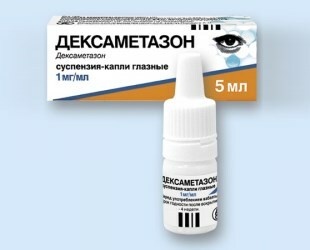
Diclofenac are eye drops with pronounced analgesic and anti-inflammatory effects.
Able to quickly alleviate severe pain, and also reduce inflammatory swelling in the place of injury.
Most often these drops are used for the prevention and treatment of various inflammations of non-infectious nature, post-traumatic inflammatory processes in the eyes, and also in the case of operations involving cataracts.
Drug Diclofenac is a slightly yellowish or completely colorless liquid that is exclusively for topical use.
- 1. Pharmacological action of
- 2. Indications for use of
- 3. How to use
- 4. Side effects of
- 5. Composition and form of
- 6. Interaction with other
- preparations 7. Contraindications
- 8. Application forof pregnancy
- 9. Precautions and special instructions
- 10. Conditions and shelf life of
- 11. Shelf life
- 12. The cost of the drug in Russia and Ukraine
- 13. Analogues
- 14. Reviews
Use the drug to prevent various inflammationitelnyh processes of infectious and non-infectious nature.
In addition, the drug has various actions such as:
- decongestant,
- antipyretic,
- analgesic,
- anti-inflammatory.
The use of this drug is a forced measure. The main distinguishing feature of Diclofenac is the rapid and rather effective relief of pain and inflammation. Symptoms that are caused by an infection of the eye, in this case, go even faster.
The main mechanism of the action of eye drops called diclofenac is suppression of the synthesis of substances that activate and support the inflammation process in the lesion, reducing the severity of possible pain, gradually reducing the severity of possible inflammatory edema.
This drug for anti-inflammatory activity is significantly ahead of such drugs as aspirin( acetylsalicylic acid), ibuprofen and butadione.
In the cornea and conjunctiva, this active substance after instillation of drops can reach the highest concentration in thirty minutes. In the systemic blood stream at high concentrations, diclofenac is not detected.
Indications for use

Eye drops Diclofenac is used for both prevention and treatment of various inflammatory non-infectious processes, such as keratoconjunctivitis, corneal erosion, conjunctivitis, posttraumatic complications on the cornea, inflammation of the conjunctiva, photophobia.
They are used for the prevention and treatment of various post-traumatic inflammations immediately after any injuries of the eyeball( both penetrating and non-penetrating) as an addition to antibiotic therapy.
The drug Diclofenac is quite effective in preventing miosis during surgical operations due to cataracts and various inflammatory processes immediately after any surgical interventions, for the prevention and treatment of cystoid edema of the macula immediately after removal of the cataract.
Method of application
Diclofenac is administered topically. It should be instilled in one drop four times a day for one to four weeks.
To inhibit the narrowing of the pupil in the case of surgery, one drop of Diclofenac drug should be instilled in the conjunctival sac even before the operation begins. After that, for two hours necessarily with breaks of 30 minutes( four times).
After cataract removal, it is necessary to instill one drop three times a day, the duration of this course of treatment should be determined by the doctor. Prevention of edema of the macula requires instillation of one drop of the drug per day four times during one month immediately after surgery.
Side effects of

Possible local reactions resulting from the use of the drug:
- burning eyes,
- blurred vision( immediately after instillation),
- iritis,
- whitening( corneal opacity).
Digestive system: vomiting and nausea.
Possible allergic reactions: hyperemia, chills, itching in the eyes, angioedema, facial swelling, fever, skin rash, urticaria, photosensitization or multiform exudative erythema.
Composition and Form of Release
One ml of this preparation contains 1 mg of diclofenac sodium, and also some auxiliary ingredients such as:
- sodium chloride,
- disodium edetate,
- propylene glycol,
- sodium hydroxide solution,
- sodium dihydrogen phosphate dihydrate,
- water for injection,
- disodium hydrogen phosphate dodecahydrate.
The form of the drug - eye drops of 0.1% in special bottles-droppers with a total capacity of 5 ml, the package includes 1 vial and a user manual for use. Also produced in a special tube-droppers with a total capacity of 1 ml, two tubes in a package.
Interaction with other drugs
Specialists do not recommend the use of Diclofenac with diflunizole, as there may be bleeding from the gastrointestinal tract, or with various NSAIDs( acetylsalicylic acid in doses / ≥3 g / day) and preparations of Methotrexate, Sulfonylureas.
Joint use of the drug Diclofenac with lithium preparations, indirect anticoagulants and digitoxin may lead to a gradual increase in their effect.
If necessary, the drug Diclofenac may be used in conjunction with other eye drops that contain SCS.The break between applications in this case should be more than 5 minutes to prevent the washing out of all active substances in the following doses.
Contraindications

Specialists do not recommend the use of eye drops Diclofenac in case of individual hypersensitivity to its components or to other anti-inflammatory non-steroid agents.
Diclofenac should not be administered to children under two years of age, or to women during pregnancy, for a period longer than 6 months.
These drops are used with extreme caution in the case of epithelial herpetic keratitis, bronchial asthma, possible bleeding disorders, as well as adolescents younger than 16 years and elderly patients.
Up to 6 months of pregnancy, you can use the drug in the event that the potential therapeutic effect for the mother is much higher than the possible risks to the fetus. For the time of treatment with these eye drops, breastfeeding must be stopped.
Pregnancy use
During pregnancy, taking the drug is justified if the potential benefit to a prospective mother is greater than the potential risk.
Breastfeeding should be discontinued when using the drug.
Precautions and special instructions for
- Wash hands thoroughly before use.
- Be sure to avoid any contact of the bottle with the eye and eyelid.
- After use, seal the tube or bottle tightly.
Taking eye drops Diclofenac is only able to mask certain signs of bacterial infection, which is why it is necessary to take into account the possible sudden development of bacterial infection as a result of the drug.
In the case of the use of this drug for a long time, it is necessary to conduct regular preventive examination of the eyes and monitor the intraocular pressure.
Do not wear contact lenses during treatment. If you can not refuse to wear contact lenses, you need to remove them 5 minutes before instillation of the drug. After using the drug, contact lenses can be dressed back in 15 minutes.
If hypersensitivity reactions( itching, sudden edema of the neck and face, redness or asthma attack) occur after taking the drug, it is necessary to stop treatment and emergency medical attention is required.
Patients with chronic rhinitis, bronchial asthma, chronic sinusitis have the risk of developing various allergic reactions in the case of aspirin or anti-inflammatory non-steroid agents.
Such anti-inflammatory drugs, as well as Diclofenac, inhibit corneal re-epithelialization and with short-term use. The degree of risk of infection and the effects of slow healing of the cornea have not yet been established.
The intake of NSAIDs increases the risk of bleeding from the eye tissues during surgery. Specialists recommend with special caution to prescribe this drug to patients with an increased risk of bleeding or patients who take drugs that can increase bleeding time.
In the case of using NSAIDs in fairly large doses for a long time, keratitis may develop.
In some cases with prolonged use of Diclofenac, particularly susceptible patients are possible:
- epithelial barrier disorder,
- corneal thinning,
- corneal infiltration,
- development of erosion, as well as corneal ulcers and corneal perforations.
All of the above complications can affect the visual function.
Conditions and storage times
Store strictly in a dark place and out of the reach of children, under temperatures between 15 ° and 25 ° C.Do not freeze. After opening the vial, it can be stored for no more than four weeks.
Shelf life
Shelf life 2 years.
The cost of the drug in Russia and Ukraine
The average price of the drug "Diclofenac" in Russia is 30 rubles, and in Ukraine 9 hryvnia.
Analogues

The following medicines are excellent analogues of this drug:
- Dexamethasone: the average cost in Russia is 69 rubles.
- Indocollar: the average cost in Russia is 46 rubles.
- Diclo F - 90 rubles.
Reviews
As a result of any infection or eye injury, their redness begins instantly, and discomfort and pain appear.
Drops of Diclofenac can quickly remove painful and inflammatory manifestations. This is due solely to the fact that the active ingredient diclofenac sodium appears on the mucosa of the eyes, and then absorbed into the blood.
It also has a curative effect, but it also has side effects. During instillation, judging by the reviews, the drug Diclofenac causes severe burning and itching in the eyes. The appearance of urticaria and erythema is also possible on the body.
Almost all the reviews about the drug Diclofenac are positive. However, there are those in which people talk about severe side effects, or those in whom the use of diclofenac caused other problems with the stomach.
In their case, the benefit from the drug was significantly less than the harm done. More details about the reviews of people who used Diclofenac for treatment, you can read at the end of this article.
